Air odyssey of Vasily Molokov
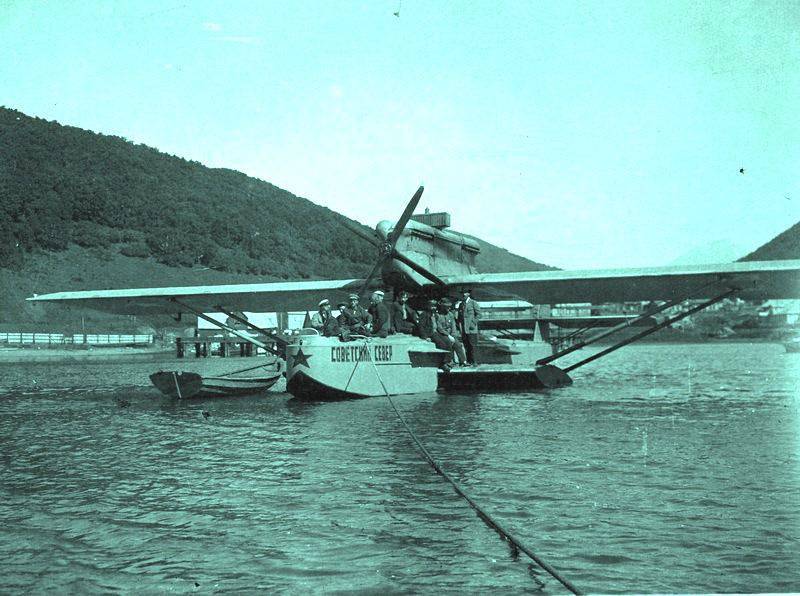
In autumn 1941, the commander of the 2nd air group of the Northern Air Force fleet Hero of the Soviet Union Colonel I. Mazuruk was summoned to Moscow at a meeting of the State Defense Committee (GKO). The question was discussed: on which way to drive combat aircraft from the USA, which we were supposed to deliver under the Lend-Lease. Ilya Pavlovich firmly stated that the shortest route along the Northern Sea Route is unsuitable: there are very few intermediate airfields and there is no fuel for refueling, and it can only be brought in for next year’s navigation. “And if through Kamchatka?” Asked Stalin. “Mountains ... Yes, you still have to fly over the sea for a long time. There are very adverse weather conditions, ”the pilot answered.
In his arguments, Mazuruk relied primarily on the experience of the Hero of the Soviet Union, Major General aviation V. Molokov, whom he came close to during the 1937 air expedition to the North Pole for the landing of the Papanin. GKO, taking into account such convincing arguments, approved the option of a Lend-Lease air route on the route Alaska - Krasnoyarsk via Chukotka, Kolyma and Yakutia.
By 1936, 40, the summer polar pilot of the Northern Sea Route Main Directorate, Vasily S. Molokov, was already primarily known for the fact that in April, 1934 managed to take the Chelyuskites {39 man) out of the ice floe, managing to take the six-seater P-5 immediately to six person. For this, among the first seven pilots, he was awarded the title Hero of the Soviet Union. By the way, at one time he was an instructor in flight training with two more pilots who became the first heroes - A. Lyapidevsky and S. Levanevsky.
After the Chelyuskin epic O. Yu. Schmidt proposed Molokov to lead the polar aviation, but he flatly refused. Again began to fly on the Yenisei airline in the Arctic. In 1935, he made his first winter voyage from Krasnoyarsk to Dikson, opening a regular flight connection with this remote Arctic village on the shores of the Kara Sea. Then he conducted ice reconnaissance in a little-studied area of the Chukchi Sea, and at the same time the first exploration of the possibility of laying a new air route through Eastern Siberia, along the route Krasnoyarsk-Yakutsk-Aldan-Kolyma.
A year later, in order to further develop Siberia, especially the Arctic coast along the entire Northern Sea Route, the crew included Hero of the Soviet Union Vasily Molokov (commander), Alexei Ritsland (navigator, also radio operator), Grigory Pobezhimov (first flight engineer) and Vladimir Mishenkov (second flight engineer) was instructed to lay the air route almost over the entire Arctic coast of our country with intermediate landings at all polar stations.
It was decided to carry out this task on the Dornier "Val" flying sea boat, having the number "USSR H-2". This aircraft was a semi-glider with two engines with a total horsepower 1400. installed tandem (type "push-pull") over the upper wing. With a maximum take-off weight of seven tons, the flying boat reached a speed of about 150 kilometers per hour and reached an altitude of 4200 meters. Run, I knew this car like my own five fingers: I flew it from 1932, at the beginning - as part of the crew of A. Alekseev, and then constantly with V. Molokov. The three of them, including navigator A. Ritsland, the crew managed to fly to the “H-2” even when performing ice reconnaissance in the Chukchi Sea.

The hydroplane was built in the cargo version - in the low compartments the man could not straighten, but you can only sit. In the meantime, four passengers were taken aboard, spreading reindeer skins and sleeping bags for them at the bottom of the boat. So flew Sergey Bergavinov, the head of the Political Administration of the Main Northern Sea Route, two political workers and the “chronicler” of the circular Arctic flight — Pravda’s special correspondent, writer Boris Gorbatov.
By the way, Pravda, Izvestia and others newspapers set aside entire bands under the large headlines for covering this flight. And if his memory has faded with time, it is only because he was soon eclipsed by the glory of non-stop flights on domestic aircrafts across the North Pole to America. Nevertheless, this does not detract from the significance of the Molokov Arctic flight. His experience turned out to be in demand even during the Great Patriotic War.
Hydroplane "USSR H-2" was launched in Krasnoyarsk from the Yenisei channel 22 July 1936. For him, except for the water surface, there were no other airfields. So Vasily Molokov had to maneuver all the time, being guided along the channels of the Yenisei, Angara, Lena and other rivers. Three times landing on the Lena - at Kirensk, Nui, Yakutsk, choosing the right places. He also noted above, where one could also make land aerodromes. From Yakutsk, the plane headed down the Lena, since it was impossible to fly directly through the tundra - because of the heat and smoke of forest fires, the engines did not pull to the desired height. Then he went to the river Aldan. Then came the difficult flight through the Verkhoyansk Range to the Kolyma.
The ridge was overcome through the Djug-Jur Pass at an altitude of about three thousand meters in clear weather. Under the wing, sharp peaks of cliffs threateningly protruded, narrow gorges darkly blackened. Had that, landing here would be impossible.
And beyond the pass the clouds moved in, so that the seaplane flew up to the shore of the Sea of Okhotsk already in the mist. As soon as the water surface flashed in the rupture of clouds, Molokov drove the car into this “window” closer to the waves. It was brought successfully in the port of Ayan. From there, soon flew along the coast to the bay Noghaevo (where now the city of Magadan).
More than four thousand kilometers of the way familiar from the flight a year ago were left behind. Then a stage of the route through the Sea of Okhotsk to Kamchatka, which was unknown to the Molokov crew, began. He was perhaps the most difficult. It was planned to immediately reach Ust-Kamchatsk. However, it was not possible to fly over the Kamchatka Ridge due to the continuous highly raised fog. I had to go down south along the coast. Molokov drove the car only ten meters from the water. But when they approached Cape Lopatka, which needed to go around, the weather became even worse: a storm raged on the water, and visibility was reduced to twenty meters. In the rain and fog bands, the shores of Kamchatka were not visible, although they are high and steep, the pilot determined the course only with white foam of the surf. Hope remained only on the skill of the navigator. And he did not let the crew down.
“Alyosha Ritsland — our laconic, always discreet and delicate navigator — surprised me with his truly jewelery work with maps and instruments,” many years later Molokov recalled the skill of his comrade with undisguised admiration.
“Now there will be Petropavlovsk,” the navigator handed the note to Molokov. But the pilot still did not see any signs of approaching the city. And Ritsland again reports: "Before us is the shore, here is the entrance to the bay." To fly into total darkness, fearing a collision with a precipice, Molokov did not dare and landed a hydroplane in the open sea, having rotated along the crest of a wave. Drove from wave to wave and soon really entered the bay, where on the berth of the pilots enthusiastically met by representatives of urban organizations. It turned out that in such a weather, even ships did not dare enter the bay.
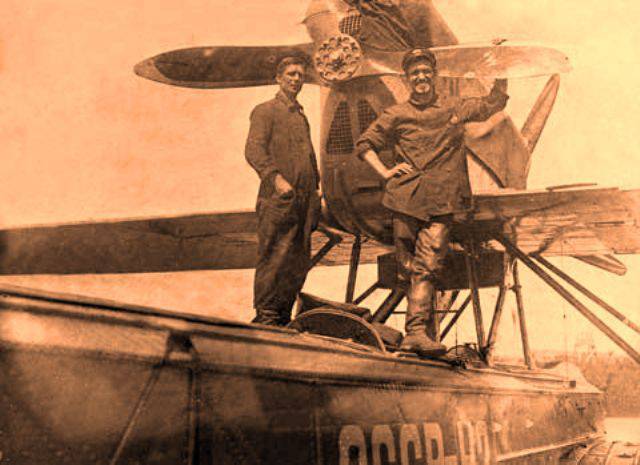
Petropavlovsk covered with thick fog. Flight mechanics took advantage of forced parking for thorough inspection and preparation of the aircraft. They diligently removed all weaknesses and the slightest malfunction. As it turned out, on time, the Kamchatka weather soon put the car and crew under even more drastic strength tests.
On the eighth of August, taking advantage of the improved weather, the crew made a detour on the H-2 in the direction of the Commander to visit Bering Island. But the dense fog made it impossible to find a lake on the island - the only place suitable for landing there. Turned to Ust-Kamchatsk. But when it was only half an hour before summer, the crew received from there a radiogram that it was closed by fog and landing there was impossible. There was only about twenty minutes left. Again, you have to sit in the open sea, and it - under the clouds.
Molokov drove the car to a decline in the clouds, in a gathering gloom. Piloted by instruments. The arrow of the altimeter is already ten meters away, but nothing is visible under the hydroplane. Then the pilot set the car in a landing position and began to smoothly and smoothly pick up speed for the most gentle planning, trying to find the surface of the sea with the bottom of the boat. Finally he felt that the tail struck the crest of the wave, and immediately completely removed the momentum. It turned out that the hydroplane splashed down on the wave of roll in one direction with the wind. But everything went pretty well. Only at the end of the race, when the boat lost speed and it began to throw hard, the crew and passengers could feel how restless the sea was.
And for more than eight hours, Molokov had to steer over steep waves, until the hydroplane buried itself in something elastic near the dimly viewed shore. In the morning it turned out that in the Kamchatka Bay, the “H-2” fell into the fishing nets of the Japanese fishing concession. It was possible to “jump out” of the nets only after disembarking passengers on the coast with the help of an inflatable boat. The Japanese, having taken Boris Gorbatov as a pilot (leather raglan and helmet), overwhelmed him with questions about what kind of equipment the Russians had if they reached the bay so precisely at night and the storm?
From the beginning of the voyage, Molokov has not taken its hands off the helm for more than 18 hours. But he still had enough strength to take on board his satellites, to fly over to the river to Ust-Kamchatsk. They breathed well and a week later headed for Korf, where they fell in torrential rain.
The route along Chukotka to Molokov was already familiar in saving Chelyuskinites. But it didn’t get any easier. Chukotka presented a nasty surprise. In an attempt by the crew to cross Cape Navarin on the way to Anadyr, the plane met a wind of such strength that it covered the distance of twenty kilometers for fifteen minutes. And suddenly, in a turbulent flow, he was thrown down as much as 300 meters. The reserve height was barely enough to avoid a collision with the ground. This risk was extremely dangerous, so we decided to go around the cape from the sea. But instead of twenty minutes I had to spend about an hour on it.
Finally arrived in Whalen, splashing in the lagoon. From there began the path along the coast of the Arctic Ocean. The Arctic met unfriendly. A wall of clouds stood in front of the winged boat "H-2" at Cape Heart-Kamen. A solid fog covered the Kolyuchinskaya lip. In the pouring rain, a hydroplane passed over Vankarem, and then a snowstorm overtook him and accompanied him to Cape Schmidt. Icing threatened - and Molokov was forced to descend to 50 meters above the sea, but still often lost sight of the coast behind a snowstorm. Only at the very cape the sun peeped through, and on a quiet lagoon, the “H-2” splashed down as it was written.
Next - a flight on about. Wrangel. And August 20 "H-2" flew to Ambarchik Bay, near the mouth of the Kolyma River. From Ambarchik to Tiksi Bay, almost 1300 kilometers were to be covered without any air bases. Therefore it was necessary to refuel with gasoline above the maximum. The boat was weighted. Molokov knew the rule: if he didn’t come off the water after a minute of run-up, it wouldn’t take off at all. Nevertheless, patiently accelerated the speed as much as three minutes twenty seconds, but still forced the car to go out of the water into the sky.
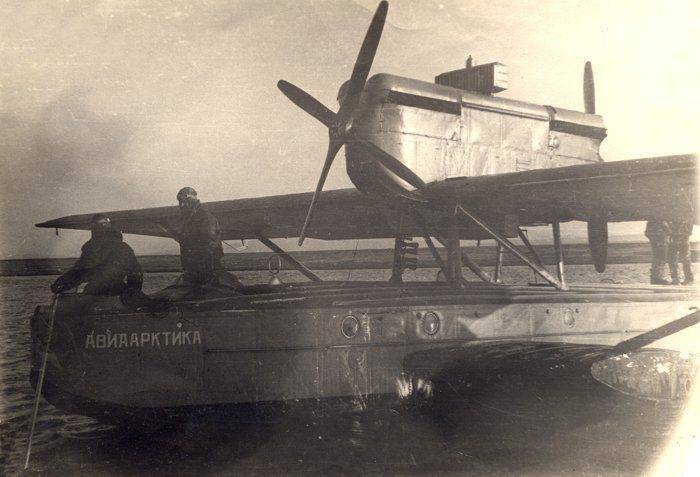
Again on the route - either snow or rain. And the headwind. The low overcast clouds pressed the winged car to the water. Until Tiksi crew made their way about ten hours. Thix Airport was then only a large aircraft box on the coast, open on one side. But nearby there were barrels of aviation gas.
Two days later we flew to Nordvik, where we found a very convenient water area for landing. But when, having set the seaplane to anchor, they went on vacation to wintering men, Molokov was given a radiogram from the Polar Aviation Administration; it was required to fly to Severnaya Zemlya to conduct ice reconnaissance to help the icebreaker Yermak, which was making its way with a convoy of ships through the ice field at Cape Chelyuskin in the Vilkitsky Strait. The crew fulfilled the mission, leaving the passengers ashore. I discovered in the area of Severnaya Zemlya a strip of pure water and with a radiogram I reported its coordinates to the captains of the ships.
Returning to Nordvik, Molokov took the passengers aboard and hurried along with the flight: a fog rolled in from the shore, a strong wind rose, catching ice floes into the bay. He took off, tacking between them, and headed for Khatanga. And there the airport turned out to be even worse than at Tiksi: only a close dugout in the desert tundra, neither warm up nor wash after a long flight. The crew spent the night in the compartment of the boat.
The next stage of the flight ended by landing on Dickson Island. Here the crew received a new mission to explore the ice in the Vilkitsky Strait, where the icebreaker Fedor Litke stood, and O. Yu. Was on board. Schmidt, with a caravan of ships. Molokov managed to find clean water only a dozen miles from the caravan. The direction in which it was necessary to break through the courts, Alexei Ritsland "tapped" them on the radio.
On the way back, the “H-2” landed on the Taimyr River near the air base, where the crew replenished the fuel and again on the flight. Dixon was approached on a moonlit, bright night, but the island was covered with fog. I had to splash down in Minin's skerries, where I could hardly find a divorce between ice floes. For one of them entrenched anchor, but soon the others began to press the seaplane. They escaped from dangerous compression, started the engines, and drove until dawn, until they found a clean water area behind one of the islands.
At Dixon, Molokov was greeted with an urgent message: “The W-2 aircraft went missing in the open sea. The Malygin aimed at the search could not find it. ” The crew of the "H-2" urgently flew to search. Three hours "combed" the area of the sea, until he found the missing person. It turned out that the pilot of the W-2, performing ice reconnaissance, was carried away in such a way that he did not have enough fuel to go back. When it ended, made a forced landing. The coordinates of this place Ritsland from the board of the "H-2" reported on the radio on Dickson, and from there sent a boat.
Then the crew intended to reach Amderma, but due to bad weather, it was necessary, bypassing Amderm, to land on Varnek Bay on Fr. Vaigach And from there they flew straight to Arkhangelsk. This last arctic stage of the route was overcome in very difficult weather conditions: strong wind, snow charges, fog accompanied the seaplane over the Kara Sea, and over the tundra of the Kanin Nos peninsula, and over the White Sea. Almost all the time, Molokov and Ritsland had to drive blindly in a continuous gray haze, in constant tension from fears: not to run into a rock, not to crash into ice toros.
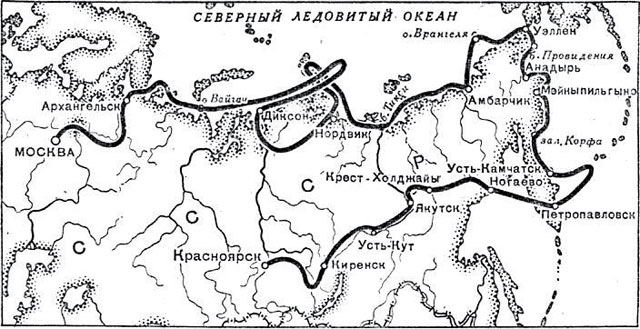
Out of the fog escaped just before Archangel. Molokov turned the car over to the mouth of the Northern Dvina, where he had cleared a patch of water from the timber rafting specifically for the reception of “H-2”. After splashing the crew was greeted by crowds of people. “Our cabin was literally covered with bunches of flowers,” Molokov later recalled.
Now the crew commander decided to keep his way to the capital, but some aviation specialists suggested that there would be no large sea cruise boat on the Moscow River. An experienced pilot insisted on himself: he knew the city and the river very well - he swam more than once. Made a request even I.V. Stalin, rested then in the Crimea. The leader replied: “If Comrade Molokov believes that he can make such a landing, let him fly,” the time of H-2 arrival in the capital was set: September 19, 17.00. The route Molokov and Ritsland developed carefully, taking into account the waterways: Arkhangelsk - Kotlas (Northern Dvina) - Vologda (Cuban Lake) - Moscow.
When the Lenin Mountains swam under the wing of a hydroplane, made a U-turn on 180º, swept a few meters over the Crimean bridge and smoothly splashed down exactly at the appointed time, evoking admiration from many who met on the granite embankment at the Park of Culture.
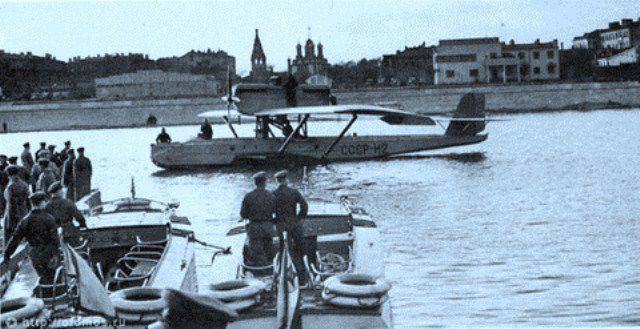
And the flight ring was closed when after the start of September 30 from Moscow on the route Kazan - Sverdlovsk (now Yekaterinburg) -Tyumen-Novosibirsk and then the Molokovsky "H-2" reached Krasnoyarsk and was moored off the Yenisei coast. This ultra-long-haul flight demonstrated to the world the possibilities of Soviet polar aviation. For 200 flight hours, the brave crew traveled a total of more than 31 thousands of kilometers. And what a path. Even now, when an airship equipped with a multitude of instruments, an autopilot and an on-board computer, along the “rolling” routes “lead, like under an elbow (according to Ilya Mazuruk’s apt remark), ground control services, flights in the Far North require quite high voltage from a person for steering wheel.
The ultra-long flight of Molokov became a kind of exam for domestic engine builders who created the M-17 engine installed on a flying boat. By decree of the Central Election Commission of the USSR, the entire crew of the USSR-H-2 was awarded orders. On merit and honor!
In 1938, VS Molokov was appointed Head of the Main Directorate of the Civil Air Fleet, and since June 1942, having received the mandate of the State Defense Committee, he supervised the construction of a land-lease air route from Alaska (Uelkal) to Krasnoyarsk, which was headed by the former head of the planning and economic department of the Civil Air Fleet D.Ye. Chusov. In this area, the total length of the 4853 kilometer in an unusually short period (ten months) was equipped with twenty-six airfields and eight air bases. Dismantling of American combat aircraft to the front began here in October of the 1942 of the year, and before the end of the 1945 of the year, 7308 aircraft were delivered along this "bridge". The route played an enormous role in the development of the regions of Chukotka, Kolyma and Yakutia, predetermined regular air traffic in these regions and gave new life to many settlements.
Sources:
Grigoriev A. Flights of Vasily Molokov // Albatrosses: From stories hydroaviation. M .: Mashinostroenie, 1989. C. 187-193.
Molokov V. Native sky. M .: Voenizdat, 1977. C.70-76.
Pavlov B. Veterans in the ranks. M .: Military Publishing. 1981. C.119-138.
Kazmin V. Ring Arctic // Civil Aviation. 1999. No.6. C. 40-42.
E. Yuzhakova. On the 80 anniversary of the Krasnoyarsk Territory: Famous pilots // Urban news". No.2923. 13.02.2014.
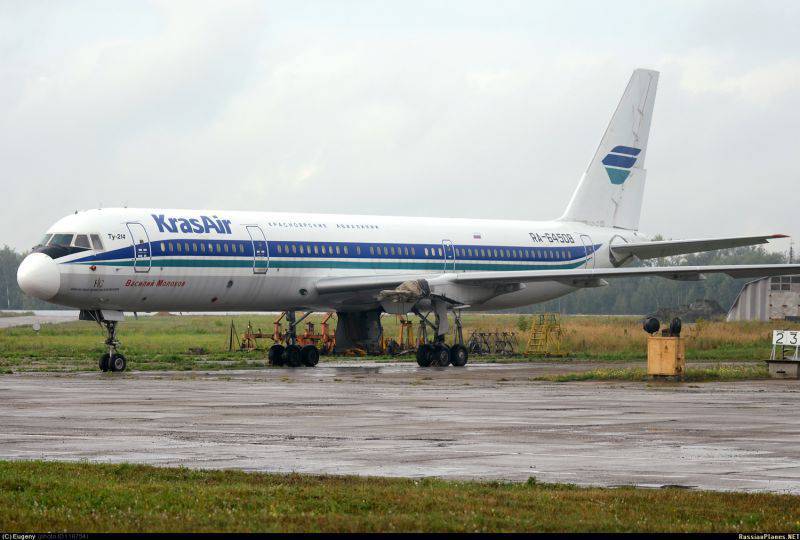
Information